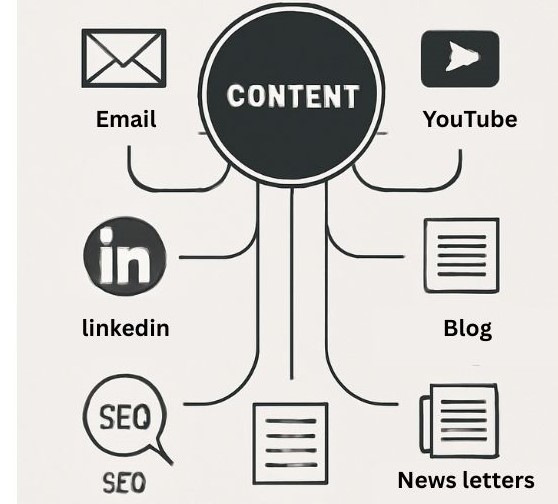In the current digitally competitive landscape, choosing the best platforms for distribution of B2B content could be the difference between a business’s growth strategy. While producing quality content is important, making sure it gets to the right decision-makers is the key to achieving results. Companies all over the USA are increasing their focus on distribution strategies that boost the visibility, engagement, and lead generation.
From emails as well as social networking platforms such LinkedIn the ability to communicate the appropriate messages at just the right moment is the key to your success. Understanding how various marketing channels affect buyer journeys is essential in maximizing reach, increasing the credibility of your brand and increasing the rate of conversions in 2025.
- What is B2B Content Marketing and Distribution?
- Why Content Distribution Matters for B2B Companies
- B2B Content Marketing Benchmarks & Trends for 2025
- The Role of AI in B2B Content Marketing
- Top B2B Content Distribution Strategies
- Best Practices for B2B Distribution Strategy
- Content Formats That Work Best in B2B Marketing
- Budget & Spending Trends in B2B Content Marketing
- Success Factors of High-Performing B2B Marketers
- Actionable Steps to Build a Scalable B2B Content Strategy
- Conclusion
What is B2B Content Marketing and Distribution?

B2B Content Marketing is the practice of generating valuable content that directly targets business owners instead of individuals. It is not just to increase brand recognition through content, but also to help with lead nurturing with marketing content through the entire sales process. Contrary to B2C where emotion drives purchases marketing for business-to-business companies is based on expertise, trust and precise details.
Distribution However, distribution is what helps get the content to the appropriate decision makers. Without the right B2B distribution channels even the most creative content is lost. Imagine publishing a book and leaving it in the garage with no readers or impact. The distribution channels used for B2B content marketing comprise social media platforms as well as email newsletters that are used in B2B marketing SEO, webinars and many more. The selection of the right methods of distribution for content marketing B2B is crucial to greater engagement.
Why Content Distribution Matters for B2B Companies
The most effective content marketing strategy can fail if distribution is not taken care of. In the present it’s impossible to run out of podcasts, blogs and videos. For B2B companies, competition can be intense. This is why strategies for social media specifically designed for B2B companies, videos marketing within B2B, and webinars to facilitate content distribution go beyond tactics. They’re also survival tools.
Smart distribution makes sure that content is delivered to the correct target audience at appropriate time. It increases the engagement of audiences by delivering content, increases effectiveness of the content strategy and boosts the effectiveness of the effectiveness of content measurement and marketing KPIs. Distribution doesn’t just mean pushing content out. It’s about making it more relevant to buyer requirements across all channels of marketing in the B2B funnel for content marketing.
B2B Content Marketing Benchmarks & Trends for 2025
Each U.S. company wants to be aware of how we evaluate the effectiveness of content marketing? Recent studies show that 73 percent of B2B marketers believe that optimizing content using AI has increased the reach of their marketing campaigns, while problems and solutions for 2025 will revolve around scaling and personalization.
Here’s a quick summary of benchmarks:
| Metric | 2025 Benchmark Average |
| B2B content performance metrics (engagement) | 5.6% CTR |
| Conversion from lead to customer | 2.8% |
| Video content effectiveness | 65% higher engagement |
| The measurement of ROI for content B2B | 70 70% of respondents track ROI often |
These numbers show the fact that content strategies based on data and measuring the impact of content are now standard requirements and not skills that require advanced training.
The Role of AI in B2B Content Marketing
Artificial Intelligence has gone from buzzwords to a the foundation of modern technology. AI application in marketing is changing the way content is sourced, created and distributed. In the present, AI content creation tools let teams create lengthy articles for B2B content more quickly while increasing the accuracy of their work.
Beyond the creation of content, automation by using AI manages distribution as well as timing and personalization on a massive scale. Through the use of AI in content creation companies can match pieces with the various stages of the customer’s journey, decrease the amount of resources wasted, and increase B2B marketing department efficiency. The question isn’t whether or not to employ AI but rather how to manage it in conjunction with human acuity.
Top B2B Content Distribution Strategies
In 2025, companies cannot depend on a single platform. A mix of content-based paid channels specifically for B2B, organic search along with social media for content marketing will ensure better reach. Platforms such as LinkedIn remain the top B2B marketing channel. YouTube and podcasts lead video marketing in B2B.
Case studies also demonstrate the importance in multi-channel strategy. For instance a SaaS company that combined B2B marketing via email and in-person events for B2B and influencer partnerships had a 37% rise in lead generation strategies B2B. The conclusion is simple that multiple distribution channels to promote B2B-specific content strategies beat single-channel focus each time.
Best Practices for B2B Distribution Strategy
Effective B2B marketing strategy requires more than simply publishing often. It starts with segmentation of the target audience in B2B, making sure that every piece is delivered to the right people. This allows for better personalization of efficiency in content marketing and is aligned with scalability of content creation objectives.
Another option is to use strategies for repurposing content. An article that is long-form in B2B content could be repurposed into a webinar, video or a sequence of emails for B2B marketing. This boosts the marketing content’s repurposing value, enhances the quality of content and increases overall B2B content performance without any additional cost.
Content Formats That Work Best in B2B Marketing
The quality of content is not all equal with the U.S. B2B market. Studies show that case studies for B2B marketing as well as whitepapers and longer-form articles in B2B content are the most dependable formats. They show an ability to think critically and have credibility.
However, buyers of today require appealing formats. The effectiveness of video content continues to climb, with webinars short-form videos and podcasts being ranked high. The combination of engagement-oriented and trust-building formats creates an ideal B2B content creation model. The objective is always to match the marketing objectives and measure content to confirm the decisions.
Budget & Spending Trends in B2B Content Marketing
2025’s spending patterns reflect the changing priorities. The reports show an average marketing budget of 9.5 percent of revenue devoted to B2B initiatives. U.S. firms are shifting money towards AI integration into marketing workflows, tools for marketing technology for B2B, as well as video content efficiency.
This shift in investment means that traditional text-based content remains important but the allocation of resources in B2B marketing is increasingly geared towards personalization and automation. As the budgeting of content marketing for 2025 develops, the leaders concentrate on balancing paid content channels that cater to B2B, while also ensuring organic reach.
Success Factors of High-Performing B2B Marketers
High-performing companies view B2B templates for content marketing are not static files, but as systems that are constantly evolving. They constantly test, tweak and implement the latest data-driven content strategies. The marketers are aware that integrating marketing and sales content can lead to better lead nurturing with content.
They also create collaborative B2B marketing teams that ensure collaboration within content teams is a key factor in creativity. They are able to integrate technology stack choices with B2B models for content creation assists them to maintain their the effectiveness of their content strategy each year.
Actionable Steps to Build a Scalable B2B Content Strategy
The process of creating scalable strategies begins by aligning content with the your customer’s journey. Study the market, develop B2B content marketing strategies and develop content creation workflows. Focus on distribution channels to support B2B content marketing to ensure the same access and visibility.
To increase scale, implement automated content using AI as well as adopt strategies to repurpose content and track the measurement of content and marketing KPIs. Case studies reveal that companies who adopted AI integration into workflows for marketing and strategies for content repurposing saw greater ROI and accelerated growth in B2B marketing services for content.
Conclusion
The environment of B2B content distribution and marketing strategies by 2025 is changing rapidly. With AI to create content video marketing for B2B and social media’s value to B2B companies, they have numerous options to reach out to decision makers. What makes the difference between winners and losers is the execution, how well they integrate with distribution and content, assess the impact of their content, and accept AI use in marketing. Businesses that are able to adapt today will be the ones to define the future of B2B’s success.
FAQs
What are the B2B distribution channels?
They include social media channels for content marketing, email newsletters in B2B marketing, webinars for content distribution, paid content channels for B2B, and in-person events in B2B.
Which is the best channel currently for B2B content distribution?
LinkedIn remains the top B2B content distribution channel in 2025 due to its professional audience and targeting features.
Which channel is best for B2B marketers?
Email marketing and LinkedIn are the most effective channels for B2B marketers today.
What are the three types of content distribution channels?
Owned, earned, and paid media channels.
What are the 4 channels of distribution?
Direct, indirect, dual distribution, and reverse channels.
What are the five major types of distribution channels in marketing?
Direct selling, retail, wholesaling, franchising, and agent/broker channels.
What is channel 3 distribution channel?
It typically involves producer → wholesaler → retailer → customer.
What are the three types of content?
Informational, promotional, and educational content.
What are the three types of distribution networks?
Intensive, selective, and exclusive distribution.
What are the three types of channels?
Communication channels, distribution channels, and service channels.
What are the three main types of media channels?
Owned, earned, and paid media.
What are the three marketing channels?
Digital, direct, and traditional marketing channels.
What is the channel of distribution in marketing SS2?
It is the path products take from producers to end-users, involving intermediaries like wholesalers or retailers.
If you found this article helpful, don’t forget to read our other blogs
